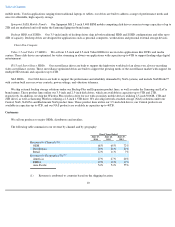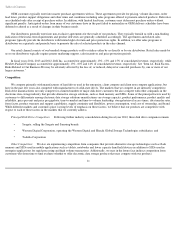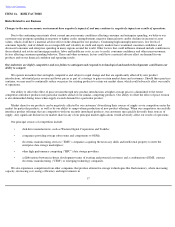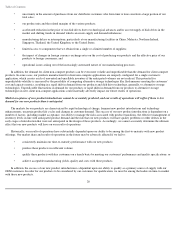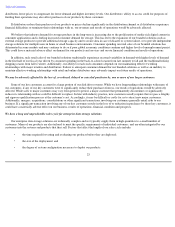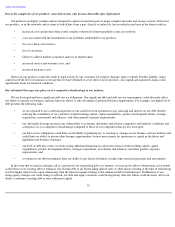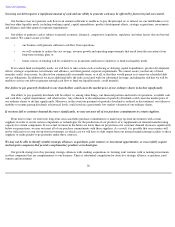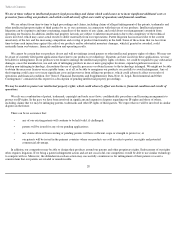Seagate 2013 Annual Report Download - page 21
Download and view the complete annual report
Please find page 21 of the 2013 Seagate annual report below. You can navigate through the pages in the report by either clicking on the pages listed below, or by using the keyword search tool below to find specific information within the annual report.
Table of Contents
performance ruggedness have resulted in competition with our lower capacity, smaller form factor disk drives. While this competition has
traditionally been in the markets for handheld consumer electronics applications, these competitors have announced solid state drives (SSDs) for
tablet, notebook and enterprise compute applications. Certain customers for both notebook and enterprise compute applications are adopting
SSDs as alternatives to hard drives in certain applications. Further adoption of these alternative storage technologies may impact the
competitiveness of our product portfolio and reduce our market share and adversely affect our results of operation.
The markets for our data storage system products are also characterized by technological change driven in part by the adoption of new
industry standards. These standards provide mechanisms to ensure technology component interoperability can occur and may reduce our
capability for differentiation or innovation and our affected products would revert to commodity status. This could lower the barriers to entry to
our market away from our specialist research and development skills and enable entry for the general-purpose design skills found in some large
EMS and CEM companies. Commodity markets are driven by extremely low margins and very aggressive competitive pricing. If our market
becomes more commoditized and we fail to deliver innovative value-added alternatives to our customers, we will have difficulty competing
against the larger EMS and CEM companies. If we are unable to compete successfully against our current and future competitors, we could
experience profit margin reductions or loss of market share, which could significantly harm our financial condition.
Our quarterly results of operations fluctuate, sometimes significantly, from period to period, and may cause our share price to decline.
In the past, our quarterly revenue and results of operations have fluctuated, sometimes significantly, from period to period. These
fluctuations, which we expect to continue, may be occasioned by a variety of factors, including:
• current uncertainty in global economic conditions may pose a risk to the overall economy;
• adverse changes in the level of economic activity in the major regions in which we do business;
• competitive pressures resulting in lower selling prices by our competitors targeted to encourage shifting of customer demand;
• delays or problems in our introduction of new products, particularly new disk drives with lower cost structures, the inability to
achieve high production yields or delays in customer qualification or initial product quality issues;
• changes in purchasing patterns by our distributor customers;
• application of new or revised industry standards;
• disruptions in our supply chain;
• increased costs or adverse changes in availability of supplies of raw materials or components;
• the impact of corporate restructuring activities that we have and may continue to engage in;
• changes in the demand for the computer systems and data storage products that contain our products due to seasonality, economic
conditions and other factors;
• changes in purchases from period to period by our primary customers;
• shifting trends in customer demand which, when combined with overproduction of particular products, particularly when the
industry is served by multiple suppliers, results in unfavorable supply/demand imbalances;
• our high proportion of fixed costs, including research and development expenses;
18




